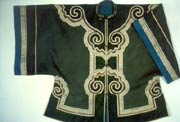"Catching the New Year"  Tujia people have many festivals, but "Catching the New Year" is the grandest and most cheerful one. Tujia people have many festivals, but "Catching the New Year" is the grandest and most cheerful one.
"Catching the New Year" means to celebrate one day before the Han nationality celebrates their New Year. If the Han nationality celebrates the New Year on lunar December 30, Tujia celebrates the New Year on December 29. The Han nationality celebrates the New Year on 29, Tujia on 28.
As to the origin of "Catching the New Year", Tujia people have a lot of popular legends in their folks. Though the stories are different or the plots differ, most of them are related to the history and wars of Tujia. The most widely spread one is the story that Tujia people catch the New Year before sending soldiers to fight against Japan in the fronts.
It is said that Japanese invaders frequently attacked the southeastern coast of China during the Ming Dynasty, when Emperor Jia Jing was in power. They set fire and killed people. The imperial court ordered and requested soldiers from Hunan and Hubei to drive away the invaders, and they should arrive at the designated coastal fronts within a definite period. The war is in an urgent phase. The military orders must be obeyed. But the New Year is also around the corner. Parents have no alternative but to celebrate the New Year ahead of time, so that the children can leave and set out on a journey after the New Year's celebration. They can hurry to the front cheerfully, to make the coastal areas and territorial seas stable and to safeguard sacred territory of the motherland. From then on, the custom of catching New Year came into being.
There are many different legends and procedures of "Catching the New Year". In the above areas, when celebrating the New Year, every household at first ought to set up a tent in the central hall with black cloth, symbolizing the barracks soldiers camped at that time. In the tent is the sacrificial table, on which are traditional meals, cured meat and cakes. Pine tree branches and plum blossom are put on the cakes, next to which is a small bamboo basket holding chopsticks. The branches and blossom stand for outskirts, and chopsticks represent arrows, to signify Tujia sons and younger brothers caught the New Year before going on an expedition that year. The custom and legends about "Catching the New Year" reflect Tujia people's grateful respect for and deep memory of their elder generations, and their sincere, everlasting patriotism.
Cogongrass Goose and Waving Dance <<
"Dong Dongkui" and "Da Liuzi" >>
|